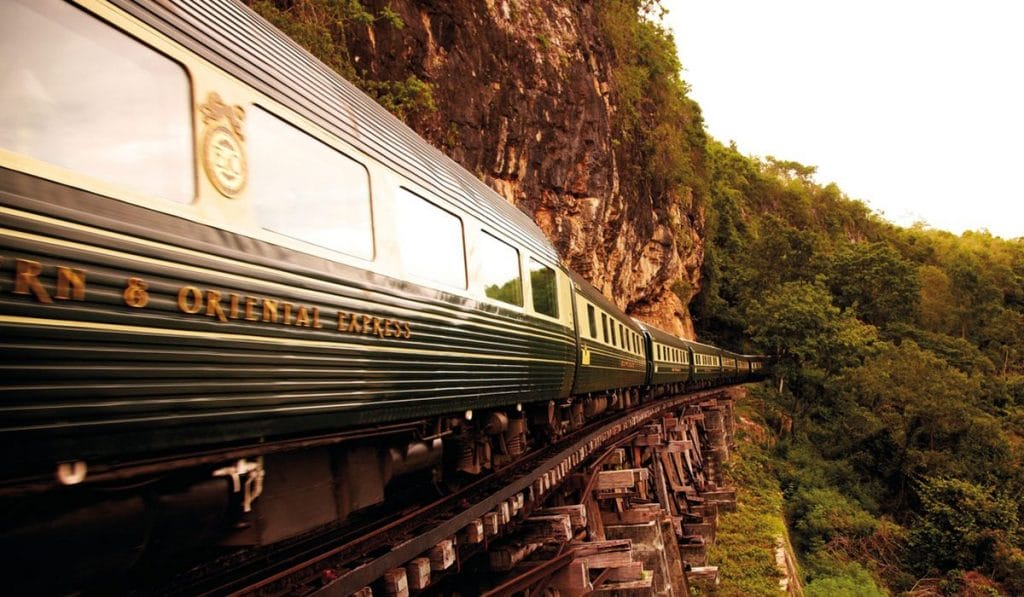A favourite regional destination among Malaysians, Bangkok is located about 1,400km (by road) away from us, and it takes about 2 hours to get there by plane. But because efficiency is not everything, The Peak boarded the Eastern & Oriental Express earlier this year, embarking on a rail trip that would transport its passengers to the Thai capital over three days – at a cost several times the price of a business-class air ticket.
It’s easy to understand the appeal of the journey. Offering a luxury train ride that is on the bucket list of many travel buffs, the Eastern & Oriental Express – with its brocade upholstery, panelled walls and teak floors – is a nostalgia-soaked, slow-paced respite from the modern world. The shortest of the journeys offered on this train, the Singapore-to-Bangkok trip takes guests through towns, plantations and forested areas, stopping at Kuala Kangsar in Perak and Kanchanaburi, Thailand, along the way. On board, life is idyllic, with a personal steward who brings you breakfast, tidies your room and sees to your requests.
But even this colonial-era throwback is not immune to the disruptive forces of the digital age. Last September, the train was outfitted with Wi-Fi connectivity for the first time, since its inaugural journey from Singapore in 1993. A constant smiling, uniformed presence during our journey, train manager Valentin Walden said: “We appreciated that the needs of travellers have evolved, and wanted to provide Wi-Fi for guests who need to stay connected while they relax.†Staying connected, however, takes a bit of effort: Wi-Fi is available only at the bar car and open-air observation car, at the end of the train’s 17 carriages.

GREAT OUTDOORS Beyond the train windows, the landscapes continually shift, from plantations and forested areas to small towns.
Internet connectivity is but one of the recent updates that have been put in place, to court a younger audience and to offer something fresh to long-time fans, some of whom have been on this train as many as 15 times. Mostly in our thirties, our group of regional journalists were among the youngest travellers on the train. Over delightful fusion meals by chef de cuisine Yannis Martineau, during day excursions, while relaxing (and trying to connect to the spotty Wi-Fi) at the bar car, and while swaying down the narrow corridors, we got acquainted with our fellow passengers – many of whom were Caucasians who appeared to be in their fifties and above.
According to Walden, “the majority of guests are British, American and Australian, followed by a mix of German, French, Japanese and Swissâ€. He added: “We are also seeing an increase in travellers from Asia. Generally speaking, many of the guests are aged 45 to 50 years old, and are successful entrepreneurs or top executives.†He has also seen an increase in young travellers looking to mark a special occasion, such as “couples choosing the train to give their honeymoon extra flairâ€.

OFF THE WALL Local graffiti artist Rajesh Kumar stands before his artwork, which adorns two carriages.
London-headquartered hotel and leisure company Belmond, which operates the Eastern & Oriental Express, has covered quite a few bases in its modernisation efforts. Commissioned to jazz up two carriages that are typically dark green and cream, Singaporean graffiti artist Rajesh Kumar created images of brightly coloured koi fish. Local DJ/producer Mr Has, who is also the Asia-Pacific music director for W Hotels, was roped in to create a soundtrack for the train. Unsurprisingly, the curated music comprises live jazz recordings and chill-out electronic music, rather than party-centric dance ditties.
During our journey, the two founders of Amsterdam-based outfit Cocktail Professor showcased the new drinks menu they had created – including concoctions such as “Malay Jungleâ€, a mix of ingredients such as tarragon, Thai basil syrup, cucumber and vodka. It’s clear that Belmond is seeking a balance between modern  coolness and the vintage charm that its existing clients expect. It’s no easy task: For instance, while my fellow journalists and I were happy to try the new cocktails before dinner, many of our fellow travellers seemed perfectly content to down tried-and-tested tipples, like a gin and tonic, or a glass of rose, while enjoying performances by a traditional Thai dancer or the train’s Singaporean resident pianist, Pete.

MEALS ON WHEELS The restaurant car offers an intimate environment where guests can enjoy multi-course meals.
A double Baileys was the nightcap of choice for an English retiree whom I struck up a conversation with one drizzly evening in the observation car. The Englishman, a former researcher at a pharmaceutical giant, shared that he had saved up his airline miles during his last five working years so he could go on trips like this one. The last time he had been on this train, he said, had been 15 years ago.
Asked how he liked the train’s changes, he expressed his approval of the Wi-Fi connectivity, which allowed him to update his Facebook account. “I’m quite particular and I only have 21 friends on it,†revealed the single traveller, adding: “Many older people are now on Facebook and the like. Just this morning, there was a Dutch couple here – they were older than me – using Facetime with their grandchildren at home.†After all, whatever your age, what is the point of taking an exceptional trip if you can’t share it with those who matter?



